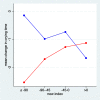Identifying potential treatment effect modifiers of the effectiveness of chiropractic care to infants with colic through prespecified secondary analyses of a randomised controlled trial
- PMID: 33874964
- PMCID: PMC8054382
- DOI: 10.1186/s12998-021-00373-6
Identifying potential treatment effect modifiers of the effectiveness of chiropractic care to infants with colic through prespecified secondary analyses of a randomised controlled trial
Abstract
Background: A recent trial identified large variation in effect of chiropractic care for infantile colic. Thus, identification of possible effect modifiers could potentially enhance the clinical reasoning to select infants with excessive crying for chiropractic care. Therefore, the aim of this study is to identify potential treatment effect modifiers which might influence the effect of chiropractic care for excessive crying in infancy.
Methods: Design: Prespecified secondary analyses of data from a randomised controlled trial. The analyses are partly confirmative and partly exploratory.
Setting: Four chiropractic clinics in Denmark.
Participants: Infants aged 2-14 weeks with unexplained excessive crying. Of the 200 infants randomised (1:1), 103 were assigned to a chiropractic care group and 97 to a control group.
Intervention: Infants in the intervention group received chiropractic care for 2 weeks, while the control group was not treated. Main analyses: The outcome was change in daily hours of crying. Fifteen baseline variables and 6 general variables were selected as potential effect modifiers, and indices based on these were constructed. Factor analyses, latent class analyses and prognosis were used to construct other potentially modifying variables. Finally, an attempt at defining a new index aiming at optimal prediction of the treatment effect was made. The predictive value for all resulting variables were examined by considering the difference in mean change in crying time between the two treatment groups, stratified by the values of the candidate variables, i.e. interaction analyses.
Results: None of the predefined items or indices were shown to be useful in identifying colicky infants with potentially larger gain from manual therapy. However, more baseline hours of crying (p = 0.029), short duration of symptoms (p = 0.061) and young age (p = 0.089) were all associated with an increased effect on the outcome of hours of crying.
Conclusion: Musculoskeletal indicators were not shown to be predictive of an increased benefit for colicky infants from chiropractic treatment. However, increased benefit was associated with early treatment and a high level of baseline crying, suggesting that the most severely affected infants have the greatest potential of benefiting from manual therapy. This finding requires validation by future studies.
Trial registration: Clinical Trials NCT02595515 , registered 2 November 2015.
Keywords: Chiropractic; Effect modification; Excessive crying; Infantile colic; Manipulative treatment; Randomized controlled trial.
Conflict of interest statement
All authors have completed the ICMJE uniform disclosure form at
They declare that LVH has received grants from the Foundation for Chiropractic Research and Postgraduate Education, the European Centre for Chiropractic Research Excellence, the Fund for General Practice, the General Practitioners’ Foundation for Education and Development, and the Research Fund for the Region of Southern Denmark at different times during the project period; LH and HWC have received grants and are supported partly by the Foundation for Chiropractic Research and Postgraduate Education; JS and DJ have no financial relationship with any organisation that might have an interest in the submitted work in the previous 3 years; no other relationship or activities that could appear to have influenced the submitted work.
Figures








Comment in
-
Response to Letter to the Editor: "The effect of chiropractic care on infantile colic: results from a single-blind randomised controlled trial" and "Identifying potential treatment effect modifiers of the effectiveness of chiropractic care to infants with colic through prespecified secondary analyses of a randomised controlled trial".Chiropr Man Therap. 2021 Aug 4;29(1):29. doi: 10.1186/s12998-021-00385-2. Chiropr Man Therap. 2021. PMID: 34348735 Free PMC article. No abstract available.
-
Letter to the Editor: "The effect of chiropractic care on infantile colic: results from a single-blind randomised controlled trial" and "Identifying potential treatment effect modifiers of the effectiveness of chiropractic care to infants with colic through prespecified secondary analyses of a randomised controlled trial".Chiropr Man Therap. 2021 Aug 4;29(1):30. doi: 10.1186/s12998-021-00386-1. Chiropr Man Therap. 2021. PMID: 34348762 Free PMC article. No abstract available.
Similar articles
-
The effect of chiropractic care on infantile colic: results from a single-blind randomised controlled trial.Chiropr Man Therap. 2021 Apr 19;29(1):15. doi: 10.1186/s12998-021-00371-8. Chiropr Man Therap. 2021. PMID: 33874955 Free PMC article. Clinical Trial.
-
The effect of chiropractic treatment on infantile colic: study protocol for a single-blind randomized controlled trial.Chiropr Man Therap. 2018 Jun 7;26:17. doi: 10.1186/s12998-018-0188-9. eCollection 2018. Chiropr Man Therap. 2018. PMID: 29930798 Free PMC article. Clinical Trial.
-
Letter to the Editor: "The effect of chiropractic care on infantile colic: results from a single-blind randomised controlled trial" and "Identifying potential treatment effect modifiers of the effectiveness of chiropractic care to infants with colic through prespecified secondary analyses of a randomised controlled trial".Chiropr Man Therap. 2021 Aug 4;29(1):30. doi: 10.1186/s12998-021-00386-1. Chiropr Man Therap. 2021. PMID: 34348762 Free PMC article. No abstract available.
-
Dietary modifications for infantile colic.Cochrane Database Syst Rev. 2018 Oct 10;10(10):CD011029. doi: 10.1002/14651858.CD011029.pub2. Cochrane Database Syst Rev. 2018. PMID: 30306546 Free PMC article.
-
Acupuncture treatments for infantile colic: a systematic review and individual patient data meta-analysis of blinding test validated randomised controlled trials.Scand J Prim Health Care. 2018 Mar;36(1):56-69. doi: 10.1080/02813432.2018.1426146. Epub 2018 Jan 17. Scand J Prim Health Care. 2018. PMID: 29338487 Free PMC article.
References
-
- Vik T, Grote V, Escribano J, Socha J, Verduci E, Fritsch M, Carlier C, Kries R, Koletzko B, for the European Childhood Obesity Trial Study Group Infantile colic, prolonged crying and maternal postnatal depression. Acta Paediatr. 2009;98(8):1344–1348. doi: 10.1111/j.1651-2227.2009.01317.x. - DOI - PubMed
-
- Rautava P, Lehtonen L, Helenius H, Sillanpaa M. Infantile colic: child and family three years later. Pediatrics. 1995;96(1 Pt 1):43–47. - PubMed
Publication types
MeSH terms
Associated data
LinkOut - more resources
Full Text Sources
Other Literature Sources
Medical

